The Ultimate Guide to Building a Freelance Portfolio That Attracts Clients in 2025

Introduction
Here’s a hard truth that might sting: clients don’t care what you say you can do—they care what you show them you’ve already done.
Your freelance portfolio that attracts high-paying clients isn’t just a collection of past work — it’s your most powerful sales tool, credibility builder, and often the difference between landing dream clients or losing them to someone more strategic.
Research from Upwork shows that 82% of clients check freelance portfolios that attract clients before reaching out. Even more telling? Freelancers with high-converting portfolios earn up to 40% more than those with generic ones.
Yet most freelancers treat their portfolio as an afterthought—rather than building a freelance portfolio that wins work, they end up with a digital dumping ground of unfocused projects.
This guide takes you from portfolio zero to portfolio hero. You’ll uncover the psychology behind what makes a freelance portfolio effective, learn how to structure case studies that convert, and get proven strategies for building a client-magnet portfolio that works 24/7.
Whether you’re starting from scratch or revamping an outdated showcase, these actionable methods will reshape how clients perceive your expertise—and help you consistently attract premium freelance opportunities.
Understanding Freelance Portfolio Psychology: What Clients Actually Look For
Building a freelance portfolio that attracts clients begins by understanding how potential clients actually make hiring decisions—and what they really look for beyond just polished visuals. It’s not just about showcasing pretty work — it’s about building trust through strategic presentation. Here’s how to create a personal brand that attracts clients on autopilot and makes your freelance portfolio stand out in a competitive market.
The Trust Equation in Freelance Portfolios
Clients make emotional decisions first—and only then justify them with logic. A freelance portfolio that attracts clients must address both: the emotional impact of presentation and the rational clarity of your value. The emotional side responds to visual appeal, professional presentation, and social proof. The rational side evaluates your problem-solving approach, measurable results, and relevant experience.
Within the first 30 seconds of visiting your freelance portfolio that attracts clients, potential clients are subconsciously asking three critical questions:

- Does this freelance portfolio that attracts clients clearly show how this freelancer can solve my specific problem?
- Do they understand my industry and challenges?
- Can I trust them with my project and budget?
Perceived Value vs. Actual Skill
Here’s where many freelancers go wrong: they focus on showcasing their skills instead of highlighting the outcomes. A high-converting freelancer portfolio doesn’t just display great work—it demonstrates how that work delivered measurable results. For example, a web developer might show off beautiful designs, but what clients really care about is whether those sites boosted conversions or improved user engagement.
Your freelance portfolio that attracts clients should answer one critical question after every project you feature: So what?
Beautiful design? So what—did it increase brand recognition or user engagement?
Clean code? So what—did it improve site speed or reduce bounce rates?
The Power of Social Proof
In a freelance portfolio that attracts clients, social proof goes far beyond testimonials. It includes client logos, performance metrics, industry recognition, and even subtle cues—like having worked with recognizable brands.
Sometimes, just one well-placed logo from a known company can dramatically boost how clients perceive your expertise.
In a freelance portfolio that attracts clients, placement matters. Don’t hide your strongest social proof at the bottom—lead with it where it instantly builds trust.
↑ Back to Table of ContentsDefine Your Freelance Niche and Ideal Client Before Building
One of the biggest mistakes freelancers make is trying to appeal to everyone. Instead of a scattered collection, build a freelance portfolio that attracts clients by showcasing your best work for a clearly defined audience.
Aligning Portfolio Content with Client Language
Your portfolio should speak your client’s language, not your industry’s jargon. If you’re a UX designer targeting SaaS companies, don’t lead with beautiful e-commerce designs. Instead, showcase user flows, conversion optimization, and metrics that SaaS founders care about—like user activation rates and churn reduction.
Here’s a practical example: Instead of saying “I created a responsive website with modern UI/UX principles,” say “I designed a lead-generating website that increased qualified inquiries by 150% in 90 days.”
The Specialization Advantage
Specialists command higher rates than generalists. A freelance portfolio that attracts clients positions you as the go-to expert in a specific area rather than someone who does “a bit of everything.”
Consider two portfolios: One shows web design, logo design, social media graphics, and brochures. Another shows exclusively SaaS dashboard interfaces with detailed case studies about improving user onboarding. Which freelancer would you hire for your SaaS project?
↑ Back to Table of ContentsBeginner Freelance Portfolio Tips: How to Build One Without Client Experience
Starting without client work doesn’t mean starting without a portfolio. Here’s how to start freelancing without experience in 2025 and still build trust and credibility from day one.. In fact, learning how to build a freelance portfolio from scratch with mock projects is a crucial step to prove your capabilities and thinking process.
Strategic Mock Projects
Mock projects aren’t busy work—they’re strategic demonstrations of your abilities. Choose projects that mirror real client challenges in your target niche.
For web designers: Redesign a local business website, focusing on conversion optimization. Document your research process, design decisions, and projected improvements.
For copywriters: Create a complete email sequence for a fictional product launch, including subject line A/B test suggestions and performance predictions. And if you’re pitching real clients, learn how to write cold emails that get responses.
For social media managers: Develop a 30-day content strategy for a real brand (without posting), complete with hashtag research, posting schedules, and engagement tactics.
The Volunteer Portfolio Strategy
Volunteering provides real client work with genuine constraints and feedback. Target nonprofits, local businesses, or startups that align with your ideal client profile.
Where to find opportunities:
- VolunteerMatch.org for nonprofit projects
- Local business networking events
- Startup incubators and accelerators
- Professional association pro bono programs
The key is treating volunteer work with the same professionalism as paid projects. Document everything, gather testimonials, and measure results wherever possible.
Case Study Structure for New Freelancers
Even without extensive experience, you can create compelling case studies by following this structure:
1. Challenge Definition (20% of content): What problem were you solving? 2. Strategic Approach (30% of content): Why did you choose this solution? 3. Execution Process (30% of content): How did you implement your strategy? 4. Results and Impact (20% of content): What outcomes did you achieve?
This structure works for both real and mock projects because it demonstrates your strategic thinking and problem-solving approach.
↑ Back to Table of ContentsFreelance Portfolio Examples That Sell: The Psychology-Driven Structure
A case study isn’t a project description—it’s a sales document. The best freelance portfolio examples use case studies to walk prospects through your problem-solving process, making it easy for them to envision working with you.
The STAR Method for Portfolio Case Studies
Adapt the STAR method (Situation, Task, Action, Result) for maximum impact:
Situation: Set the scene with context that resonates with your target clients Task: Define the specific challenge or goal Action: Detail your strategic approach and execution Result: Quantify the outcomes and impact
Psychology-Based Case Study Structure
Hook (First 2 sentences): Start with the most impressive result or an intriguing problem Context (1 paragraph): Provide just enough background without boring details Challenge (1-2 paragraphs): Explain the specific problem and why it mattered Solution (2-3 paragraphs): Detail your approach, tools, and decision-making process Results (1-2 paragraphs): Quantify outcomes with specific metrics Client Voice (1 paragraph): Include a testimonial that reinforces your impact
Real-World Case Study Example
Hook: “How a 15-minute user onboarding flow redesign increased trial-to-paid conversions by 340% for a B2B SaaS startup.”
Context: TechFlow, a project management SaaS serving marketing agencies, was losing 78% of trial users within the first week without completing setup.
Challenge: The existing onboarding required users to configure multiple integrations and settings before seeing value, creating a friction-heavy experience that overwhelmed new users.
Solution: I redesigned the onboarding flow using progressive disclosure principles, allowing users to see immediate value before requesting complex setup steps. Key changes included:
- Simplified initial setup to 3 core steps
- Added interactive product tours with real sample data
- Implemented smart defaults based on user-selected use cases
- Created contextual help tooltips for advanced features
Results: Within 60 days of launch:
- Trial-to-paid conversion increased from 12% to 53%
- Time-to-first-value decreased from 47 minutes to 8 minutes
- User support tickets related to onboarding dropped by 67%
Visual Summary of Results
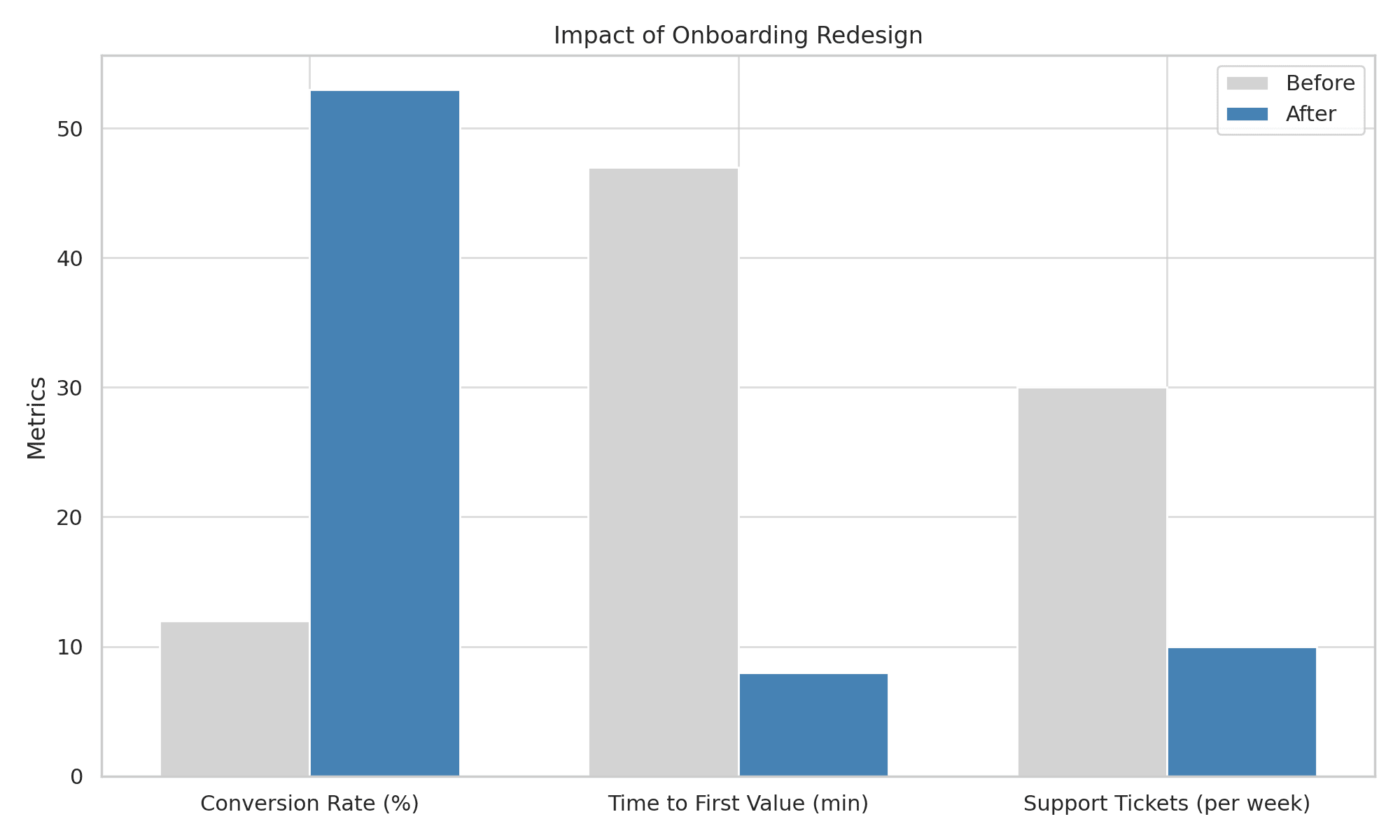
Client Voice: “The onboarding redesign completely transformed our user experience. We went from constantly explaining our product to having users understand and engage immediately.” – Sarah Chen, Founder, TechFlow
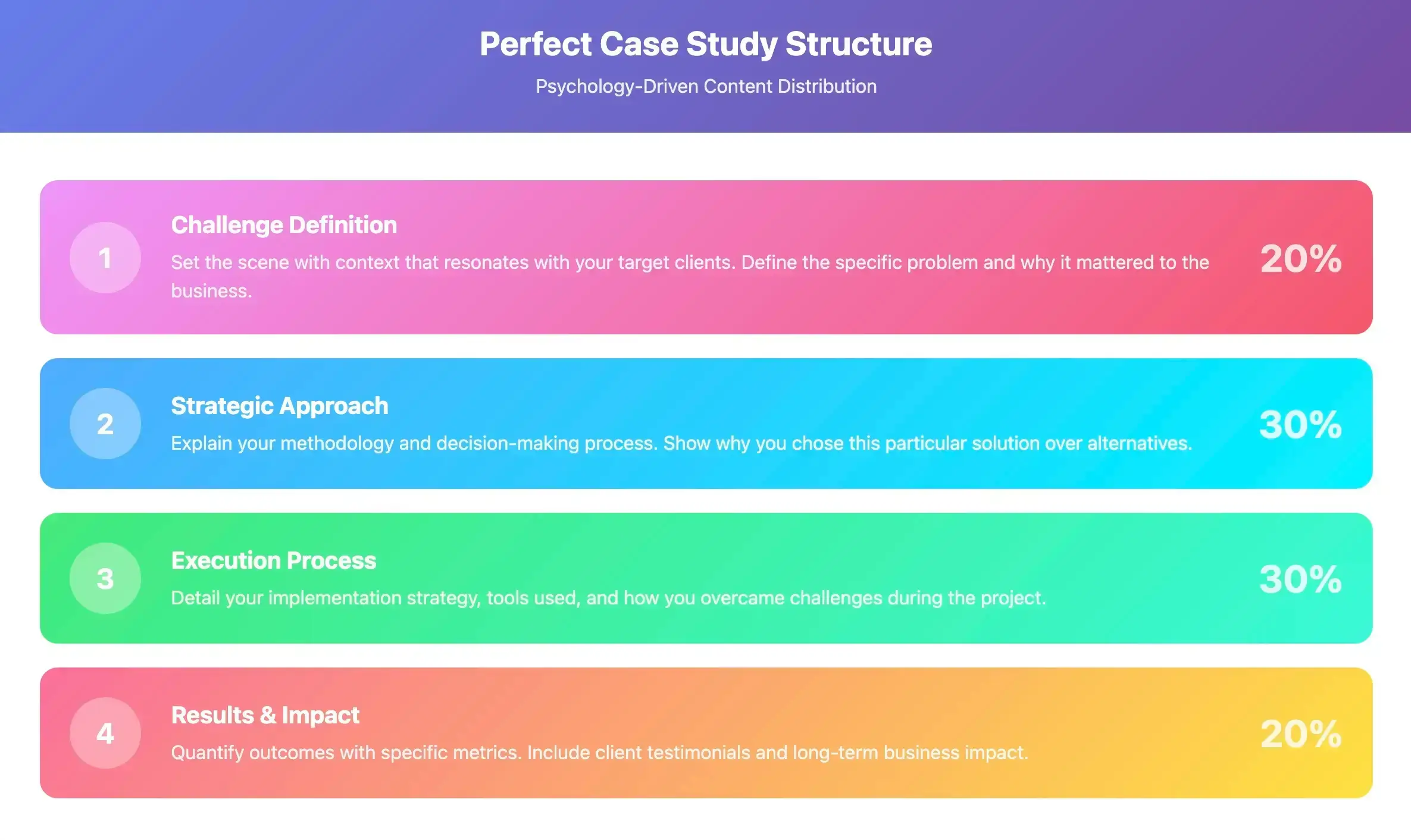
Leveraging AI for a Winning Freelance Portfolio in 2025
Artificial intelligence isn’t a future luxury—it’s a present-day portfolio advantage. In 2025, tools like ChatGPT, Midjourney, and Jasper are helping freelancers save time, increase conversion, and present their value with greater clarity and personalization.
1. AI-Powered Case Study Development
Use ChatGPT or Gemini to structure compelling case studies. Simply provide your raw inputs—problem, solution, results—and let AI help format it using the STAR method or persuasive storytelling techniques.
Prompt example:
“Transform these bullet points into a STAR-format case study for my SaaS design portfolio:
– Client: Fintech startup struggling with 80% onboarding drop-off
– Solution: Redesigned flow using progressive disclosure
– Result: Increased conversions by 340% in 60 days”
You can even ask AI to generate testimonial drafts, rewrite dry descriptions into benefit-driven narratives, or customize each case study for different client segments.
Top AI Tools Freelancers Use in 2025:
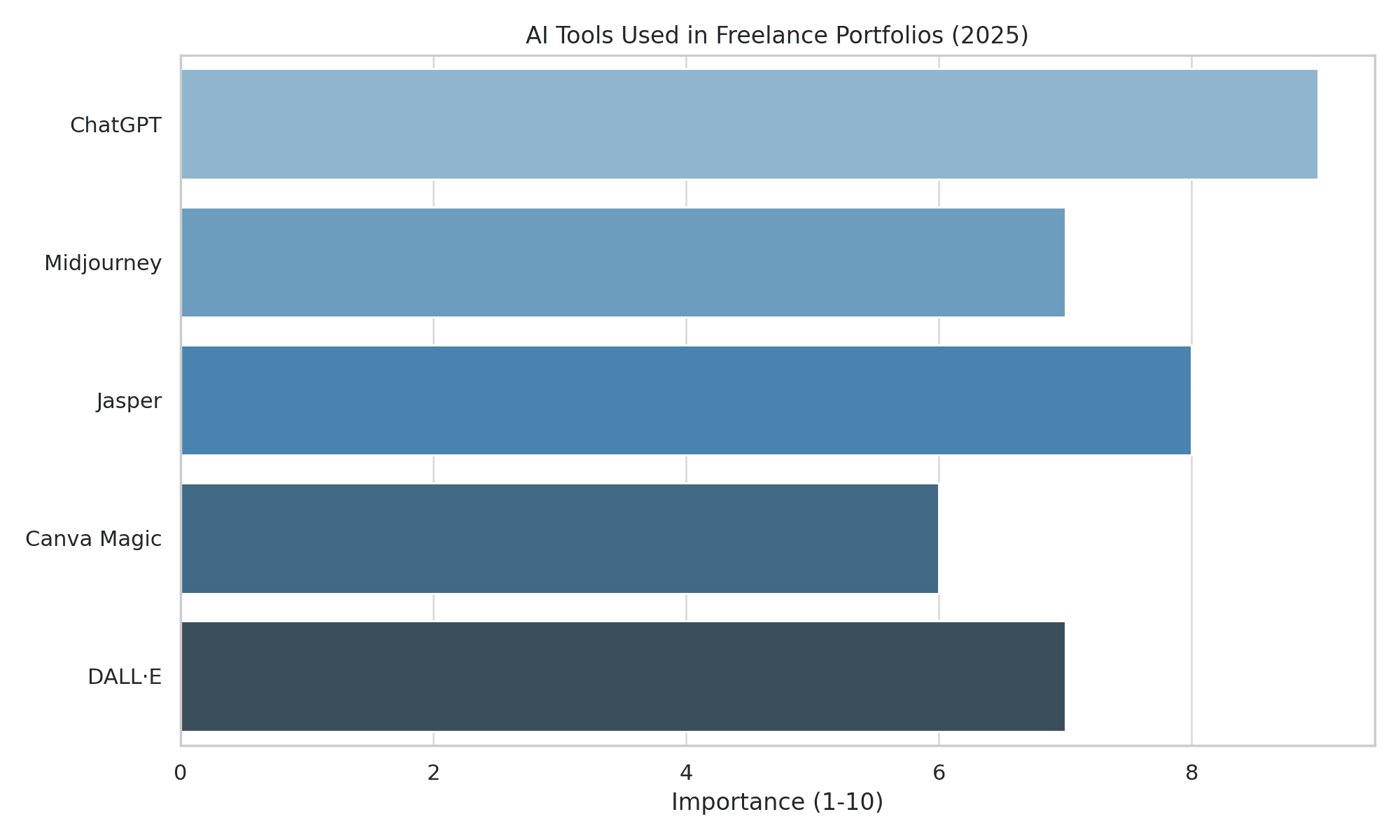
2. AI for Visual Portfolio Elements
Even non-designers can use tools like Midjourney or DALL·E to generate visuals for mock projects.
Prompt example:
“Minimalist SaaS dashboard redesign in light blue/gray, professional style.”
Designers can speed up workflow with Canva’s Magic Design or create before/after sliders to emphasize impact visually.
3. AI-Driven SEO & Personalization
Use ChatGPT or Jasper to create keyword-rich metadata, niche-specific CTAs, and even dynamic landing page variations.
Prompt example:
“Write a 150-character meta description for my UX portfolio specializing in healthtech apps. Keywords: ‘healthtech UX designer’, ‘HIPAA-compliant design’. Emphasize conversion benefits.”
With AI, you can A/B test your CTAs—for example:
“Book a free UX audit” vs. “Get startup-friendly rates”—depending on your audience.
4. Ethics and Transparency Matter
✅ Best Practices:
- Disclose AI-assisted content if required by clients
- Fact-check all metrics and data
- Use AI as a writing/design assistant—not as a truth source
❌ Avoid:
- Faking testimonials or case studies
- Copy-pasting generic AI content without editing
- Misrepresenting tools or results
Where to Showcase AI in Your Portfolio
- “Tools & Methods” section: Include AI tools you use
- Footnotes: Indicate when AI helped structure or refine the content
- Blog: Share your AI workflow publicly to show transparency and thought leadership
📌 Pro Tip: Add a screenshot of your ChatGPT prompt-output flow inside your portfolio to demonstrate modern, tech-savvy processes.
By integrating AI with transparency and creativity, you save hours and showcase that you’re not just a skilled freelancer—but a future-ready problem solver.
↑ Back to Table of ContentsChoosing the Right Platform for Your Portfolio
Here’s a quick visual comparison of the most popular platforms freelancers use to host their portfolios based on niche and budget.
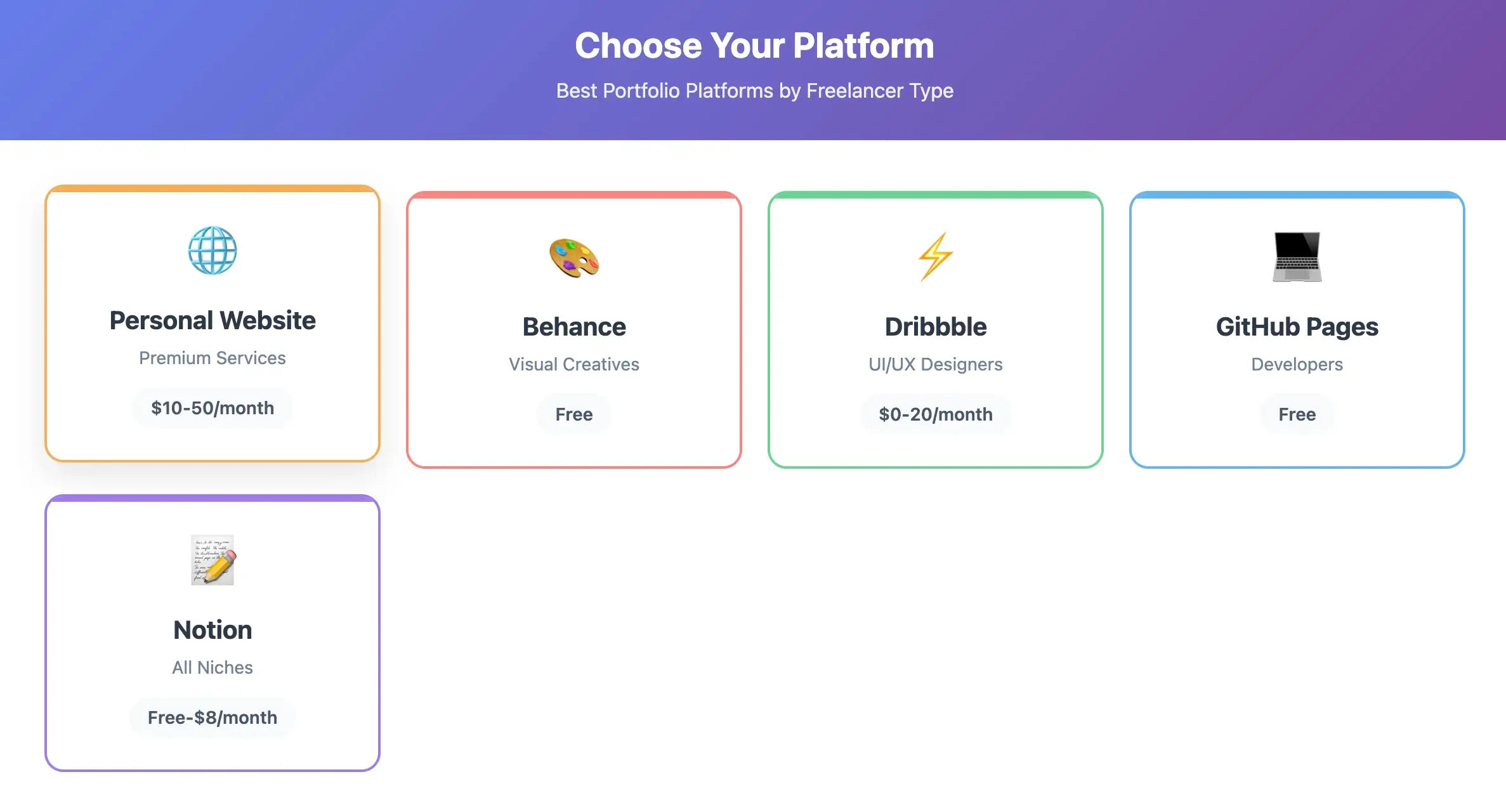
Your platform choice significantly impacts how clients perceive your professionalism and expertise. Different niches benefit from different approaches. If you’re unsure whether you need a full website or just a portfolio platform, read this comparison of freelancer websites vs portfolio platforms to choose what fits your goals best.
Platform Comparison by Freelancer Type
| Platform | Best For | Pros | Cons | Cost |
|---|---|---|---|---|
| Personal Website | All niches, especially premium services | Full control, professional appearance, SEO benefits | Requires maintenance, higher cost | $10–50/month |
| Behance | Visual creatives (designers, photographers) | Built-in audience, easy to use | Limited customization, Adobe ecosystem | Free |
| Dribbble | UI/UX designers | Industry recognition, peer feedback | Invite-only, less client-focused | $0–20/month |
| GitHub Pages | Developers, technical writers | Free, version control, credibility with developers | Technical setup required | Free |
| Notion | All niches, great for beginners | Easy to set up and update, cost-effective | Limited design options | Free–$8/month |
When You Need Your Own Website
Invest in a personal website when:
- You’re charging premium rates ($75+/hour or $5000+ projects)
- You want to appear in Google searches for your services
- You need to integrate booking, payment, or CRM systems
- Your target clients expect a high level of professionalism
Portfolio Website Essential Elements
Homepage must include:
- Clear value proposition within 5 seconds
- Your primary service and target client
- Strong portfolio preview (3-4 best pieces)
- Social proof prominently displayed
- Clear contact call-to-action
Portfolio section needs:
- 6-12 carefully selected projects
- Detailed case studies for your 3 best projects
- Easy navigation between projects
- Mobile-optimized image display
Professional Portfolio Design That Builds Trust
Your portfolio’s design communicates your professionalism before visitors read a single word. Even if you’re not a designer, following key principles will dramatically improve how clients perceive your expertise.
The 7-Second Rule
Research shows visitors form impressions of websites within 7 seconds. Your portfolio needs to communicate credibility, relevance, and quality immediately.
Visual hierarchy priorities:
- Your name and what you do
- Your strongest work sample
- Social proof (testimonial or client logo)
- Clear navigation to more work
Color Psychology for Freelance Portfolios
Different colors communicate different values:
- Blue: Trust, reliability, professionalism (ideal for consultants, agencies)
- Black/Gray: Sophistication, premium positioning (luxury brands, high-end services)
- White/Minimal: Clean, modern, focused (designers, developers)
- Green: Growth, money, stability (financial services, business consultants)
Avoid bright, playful colors unless they align with your brand and target market. When in doubt, choose a neutral palette with one accent color.
Mobile-First Portfolio Design
Over 60% of portfolio visits happen on mobile devices. Design for mobile first, then enhance for desktop.
Mobile optimization checklist:
- Images load quickly (under 3 seconds)
- Text is readable without zooming
- Navigation works with thumbs
- Contact information is easily accessible
- Portfolio pieces display clearly on small screens
No-Code Tools for Professional Portfolios
You don’t need coding skills to create a professional portfolio:
Webflow: Best for custom designs without coding Framer: Excellent for interactive, animated portfolios Carrd: Perfect for simple, single-page portfolios WordPress + Elementor: Maximum flexibility with templates
↑ Back to Table of ContentsMastering Social Proof in Your Portfolio
Social proof transforms your portfolio from a collection of work samples into a trust-building machine. The key is strategic collection and presentation of client feedback.
The Psychology of Portfolio Testimonials
Testimonials work because they reduce perceived risk. When prospects see that others have successfully worked with you, it becomes easier to imagine their own positive experience.
Most effective testimonial types:
- Result-focused: “Sarah increased our conversion rate by 45%”
- Process-focused: “Working with Mark was seamless—he understood our vision immediately”
- Character-focused: “Lisa was reliable, professional, and delivered early”
How to Collect Powerful Testimonials
Don’t wait for clients to volunteer testimonials—actively request them using this proven method:
The 3-Question Email Template:
- What specific results did you achieve from our project?
- What was it like working with me compared to other freelancers?
- Would you recommend me to others in your industry, and why?
Send this email 2-3 weeks after project completion when results are clear but the experience is still fresh.
Video Testimonials: The Trust Multiplier
Video testimonials are 10x more persuasive than written ones because they’re harder to fake and convey genuine emotion. Even smartphone-recorded videos work well if the content is strong.
How to get video testimonials:
- Offer a discount on future services in exchange for a 2-minute video
- Provide a simple script or talking points
- Make it easy by offering to record a quick video call
- Focus on results and experience rather than technical details
Client Logo Strategy
Displaying client logos builds credibility through association. Even if you’ve worked with smaller companies, present their logos professionally.
Logo display best practices:
- Use consistent sizing and spacing
- Convert to grayscale for uniformity
- Group by industry or alphabetically
- Update regularly to show recent work
SEO Optimization for Your Freelance Portfolio
A beautiful portfolio that no one finds is useless. SEO ensures your ideal clients discover your freelance portfolio that attracts clients when searching for relevant services.
Keyword Research for Freelance Portfolios
Focus on “hiring intent” keywords rather than general industry terms. Your ideal clients aren’t searching for “graphic design tips”—they’re searching for “freelance graphic designer for tech startups.”
Primary keyword formula: “Freelance [Your Service] for [Your Niche]”
Examples:
- “Freelance copywriter for SaaS companies”
- “Freelance web developer for restaurants”
- “Freelance social media manager for real estate agents”
On-Page SEO for Portfolio Sites
Title tag optimization:
- Include your primary keyword
- Keep under 60 characters
- Make it compelling, not just keyword-stuffed
Example: “Freelance UX Designer for SaaS | Increase User Retention by 40%”
Meta description strategy:
- Summarize your value proposition in 150 characters
- Include your primary keyword naturally
- Add a call-to-action
Example: “Freelance portfolio that attracts clients through conversion-focused UX design. Helping SaaS companies reduce churn and increase user engagement. View case studies.”
Image Optimization for Portfolios
Portfolio images often account for 80% of page load time. Optimize for both speed and SEO:
Technical optimization:
- Compress images to under 100KB when possible
- Use WebP format for better compression
- Implement lazy loading for faster initial page loads
SEO optimization:
- Use descriptive file names: “saas-dashboard-redesign-case-study.jpg”
- Write detailed alt text: “Before and after screenshots showing improved user onboarding flow for SaaS dashboard”
- Include relevant keywords naturally in alt text
Local SEO for Location-Based Freelancers
If you serve local clients, optimize for location-based searches:
- Include your city/region in key pages
- Create location-specific landing pages if serving multiple areas
- Claim and optimize your Google My Business profile
- Encourage location-based reviews
Maintaining a Living, Breathing Portfolio
Your portfolio should evolve with your skills and market demands. A static portfolio quickly becomes outdated and less effective at attracting new clients.
Portfolio Update Schedule
Monthly: Review analytics to see which projects generate the most interest Quarterly: Add new case studies and remove outdated work Bi-annually: Refresh design elements and update your positioning Annually: Complete portfolio audit and strategic overhaul
Automation Tools for Portfolio Management
Notion + Zapier integration: Create a Notion database for projects that automatically updates your portfolio when you add new work. This ensures consistency and saves time.
Google Analytics + Google Data Studio: Track which portfolio pieces generate the most client inquiries and optimize accordingly.
Testimonial collection automation: Set up automated email sequences to request testimonials at optimal times post-project.
Portfolio Integration Strategy
Your portfolio shouldn’t live in isolation. Integrate it across all client touchpoints:
Email signature: Link to your best case study relevant to each recipient LinkedIn profile: Feature section showcasing portfolio highlights Proposal templates: Include relevant portfolio pieces in every proposal Social media: Regular portfolio updates and behind-the-scenes content
↑ Back to Table of ContentsCommon Portfolio Mistakes That Repel Clients
Even experienced freelancers make critical portfolio mistakes that undermine their credibility and reduce client conversions.
The “Everything” Portfolio Problem
Showing every project you’ve ever completed dilutes your expertise. Clients prefer specialists over generalists, especially for complex or high-value projects.
Solution: Curate ruthlessly. Show 8-12 pieces maximum, all aligned with your positioning and ideal client profile.
Amateur Design Red Flags
Poor design communicates unprofessionalism, regardless of your actual service quality.
Common design mistakes:
- Inconsistent fonts and colors
- Poor quality or improperly sized images
- Cluttered layouts with too much information
- Broken links or slow loading times
- Mobile-unfriendly design
Missing Calls-to-Action
Many portfolios showcase beautiful work but fail to guide visitors toward the next step. Every portfolio page should include a clear, relevant call-to-action.
Effective CTA examples:
- “Ready to discuss your project? Schedule a free consultation”
- “See how I can help your business grow—get in touch today”
- “Download my free [relevant resource] and let’s connect”
Context-Free Work Display
Showing work without context forces clients to guess at your capabilities. Always provide background, challenges, and results for featured projects.
Before: “Logo design for tech startup” After: “Brand identity that helped early-stage SaaS startup raise $2M Series A funding by communicating credibility and vision to investors”
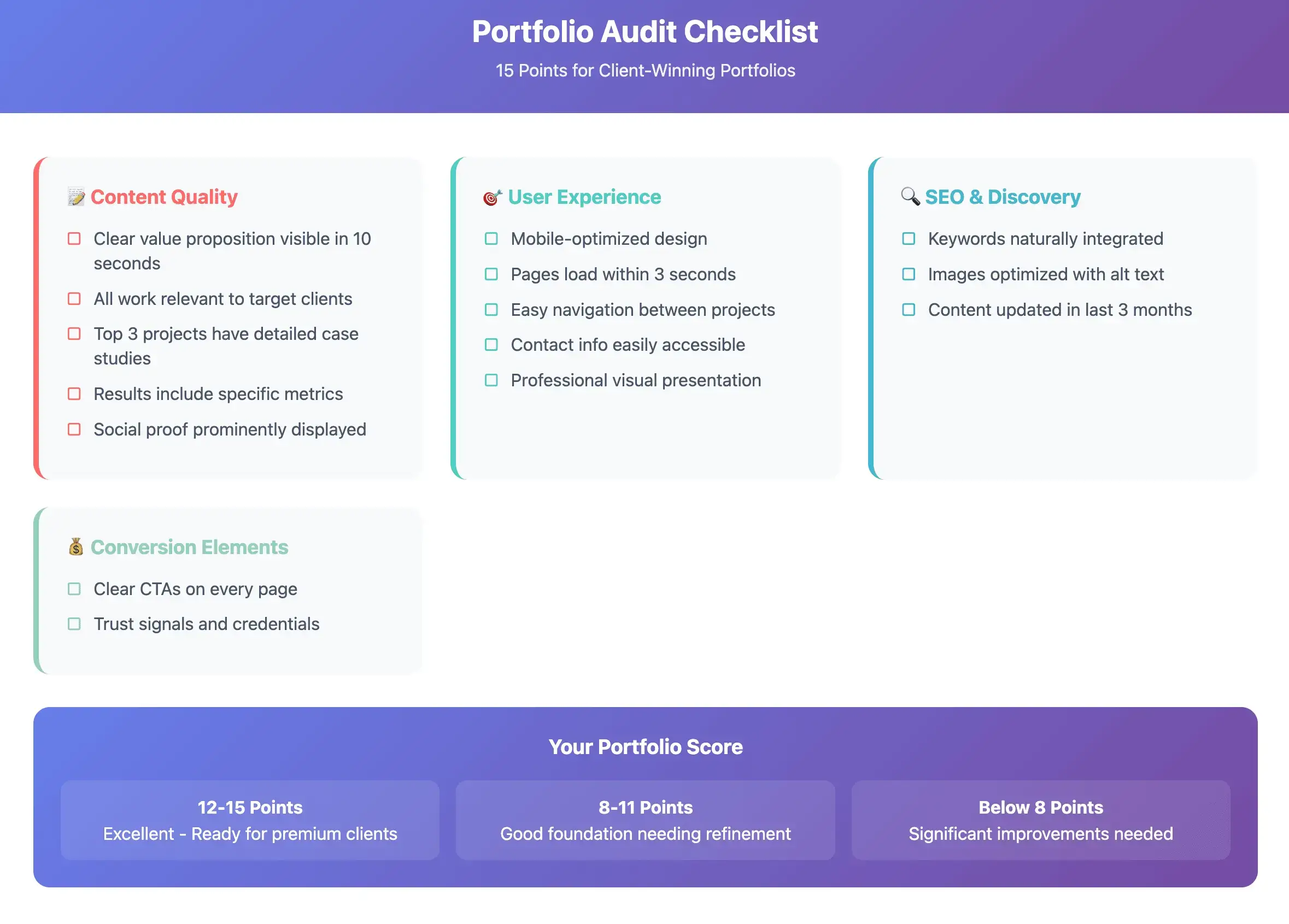
This freelance portfolio audit checklist helps you identify and fix weak areas that might be repelling clients. Follow these 15 proven guidelines to attract better freelance opportunities in 2025.
↑ Back to Table of ContentsPortfolio Audit Checklist: 15 Points for Client-Winning Portfolios
Use this comprehensive checklist to evaluate and improve your freelance portfolio:
Content Quality
- Clear value proposition: Can visitors understand what you do and who you serve within 10 seconds?
- Curated work selection: Are all portfolio pieces relevant to your target clients?
- Detailed case studies: Do your top 3 projects follow the structure of a high-converting freelancer portfolio by clearly presenting the problem, process, and measurable results?
- Quantified results: Have you included specific metrics and outcomes where possible?
- Social proof placement: Are testimonials and client logos prominently displayed?
User Experience
- Mobile optimization: Does your portfolio look and function well on smartphones?
- Loading speed: Do all pages load within 3 seconds?
- Easy navigation: Can visitors quickly find specific types of work?
- Contact accessibility: Is your contact information easy to find on every page?
- Professional presentation: Does the overall design communicate credibility?
SEO and Discoverability
- Keyword optimization: Are relevant keywords naturally included in titles and descriptions?
- Image optimization: Are all images properly compressed and have descriptive alt text?
- Content freshness: Have you updated your portfolio within the last 3 months?
Conversion Elements
- Clear CTAs: Does each page guide visitors toward a specific next step?
- Trust signals: Have you included relevant credentials, certifications, or awards?
Scoring: Give yourself 1 point for each “yes” answer.
- 12-15 points: Excellent portfolio ready to attract premium clients
- 8-11 points: Good foundation needing refinement
- Below 8 points: Significant improvements needed
Frequently Asked Questions
What should I include in my portfolio if I don’t have client work yet?
Start with strategic mock projects that demonstrate your skills and thinking process. Choose projects that mirror real challenges your ideal clients face. Include personal projects, volunteer work, or spec work that shows your capabilities. The key is presenting them professionally with clear problem-solution narratives, even if they weren’t paid client projects.
How many projects should I include in my freelance portfolio?
Quality beats quantity every time. Include 8-12 carefully selected projects that align with your positioning and target clients. It’s better to have 6 excellent, detailed case studies than 20 mediocre project thumbnails. Focus on work that demonstrates progression in your skills and results you’ve achieved for clients.
Can I include projects I worked on as part of a team?
Absolutely, but be transparent about your specific contributions. Clearly state your role, what parts you were responsible for, and how you contributed to the overall success. Many client projects involve collaboration, so showing you can work effectively in teams can actually be a selling point.
How often should I update my portfolio?
Add new work quarterly and conduct a full portfolio audit annually. Remove outdated work that no longer represents your current skill level or target market. Keep your portfolio fresh by regularly adding case studies from recent projects and updating testimonials. If you notice certain portfolio pieces aren’t generating client interest, consider replacing them with more relevant work.
Should I include pricing information in my portfolio?
Generally, no. Pricing discussions are better handled during consultations where you can tailor proposals to specific project requirements. However, you might include starting ranges for specific services if you want to qualify leads and attract clients with appropriate budgets. Focus your portfolio on value demonstration rather than price competition. When choosing between hourly, fixed, or value-based models, understanding different freelance pricing strategies becomes essential for positioning your services correctly and attracting clients who value outcomes over hours.
A freelance portfolio that attracts clients isn’t a one-time task—it’s an evolving tool that should grow with your skills and reputation.
By consistently refining and updating a freelance portfolio that attracts clients, you’re building a long-term asset that generates opportunities even when you’re not actively pitching.
Transform Your Portfolio Into a Client Magnet
Your freelance portfolio isn’t just a showcase—it’s your most powerful business development tool. When built strategically, it works 24/7 to attract ideal clients, demonstrate your expertise, and build trust for high-value projects.
The difference between freelancers who struggle and those with consistent inbound leads often lies in how they present their work. Your skills matter, but your presentation, structure, and clarity of value are what turn casual visitors into paying clients.
In 2025, standing out requires more than just good work—it demands a freelance portfolio that attracts clients through clarity, relevance, and results.
A well-structured freelance portfolio that attracts clients blends storytelling, proof, and positioning to drive conversions without needing to chase leads.
Start by reviewing your current setup. Begin with a portfolio audit using our checklist, then focus on creating one compelling case study that demonstrates both your process and results. Small, consistent improvements will compound into significant business growth.
🔗 Related Reads to Boost Your Portfolio Strategy
- Freelancer Website vs Portfolio: Which One Do You Really Need?
- Start Freelancing Without Experience in 2025: Ultimate Guide
- How to Create a Personal Brand That Attracts Clients on Autopilot
- How to Write a Cold Email That Gets Responses From Potential Clients
- How to Attract High-Paying Clients
Join our FreelanceBoosters Telegram channel for weekly portfolio tips, client acquisition strategies, and exclusive resources for ambitious freelancers.

